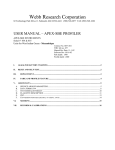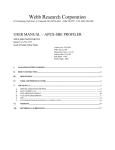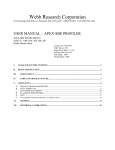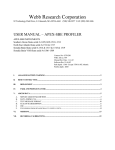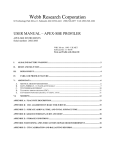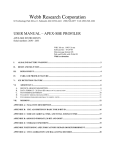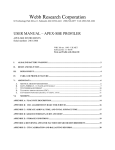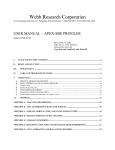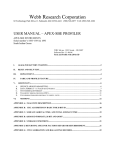Download User Manual 796 UK m.. - Argo Information Centre
Transcript
Webb Research Corporation 82 Technology Park Drive, E. Falmouth, MA 02536-4441 (508) 548-2077 FAX (508) 540-1686 USER MANUAL – APEX-SBE PROFILER APEX-SBE INSTRUMENTS Serial #s 535 & 536 Contract Swale Oceanographic #0152/244 WRC Job no. UK Met #796 Manual Rev Date: 2-22-02 Software Rev 10-17-01 Profile depth: 2000 db, ARABIAN SEA I. ALKALINE BATTERY WARNING...............................................................................................................2 II. RESET AND SELF TEST.................................................................................................................................2 III. DEPLOYMENT ............................................................................................................................................3 IV. ARGOS DATA ..............................................................................................................................................4 A. B. C. D. E. F. V. VI. SERVICE ARGOS PARAMETERS...............................................................................................................4 DATA FORMAT #1 .......................................................................................................................................5 TEST MESSAGE FORMAT ..........................................................................................................................9 FLAG BYTE DESCRIPTION ......................................................................................................................10 CRC...............................................................................................................................................................12 CONVERSION FROM HEXADECIMAL TO USEFUL UNITS ....................................................................................13 MISSIONS ........................................................................................................................................................14 RECORDS & CALIBRATIONS ...............................................................................................................15 I. ALKALINE BATTERY WARNING The profiler contains alkaline "D" cells. There is a small but finite possibility that batteries of alkaline cells will release a combustible gas mixture. This gas release generally is not evident when batteries are exposed to the atmosphere, as the gases are dispersed and diluted to a safe level. When the batteries are confined in a sealed instrument mechanism, the gases can accumulate and an explosion is possible. Webb Research Corp. has added a catalyst inside of these instruments to recombine Hydrogen and Oxygen into H2O, and the instrument has been designed to relieve excessive internal pressure buildup by having the upper endcap release. Webb Research Corp. knows of no way to completely eliminate this hazard. The user is warned, and must accept and deal with this risk in order to use this instrument safely as so provided. Personnel with knowledge and training to deal with this risk should seal or operate the instrument. Webb Research Corp. disclaims liability for any consequences of combustion or explosion. II. Reset and Self Test Profilers are shipped to the deployment site in Hibernate mode. Shortly before deployment, reset the profiler by passing a magnet over the marked location on the pressure case. The profiler will run a self-test, transmit for 6 hours with the bladder extended, and then begin its preprogrammed mission. The six ARGOS transmissions during self-test and the transmissions during the initial 6 hour period contain data about the instrument and are outlined in (V) ARGOS DATA, part (C) TEST MESSAGE FORMAT. Procedure: 1. Secure float in horizontal position, using foam cradles from crate. IMPORTANT: Remove three plugs from Seabird sensor, if they have not already been removed. 2. Minimum temperature –2 deg C. If necessary, let float warm indoors before proceding. 3. Carefully pry black rubber plug out of bottom center of yellow plastic cowling to verify bladder inflation (per below). Be sure to replace plug before deployment. Note: it can be very difficult to replace plug when air bladder is fully inflated. Replace plug during beginning of air bladder inflation. Purpose of plug is to prevent silt entry if float contacts sea floor. 2 4. Hold the provided magnet at RESET position marked on the hull for several seconds. Note: The internal magnetic reed switch must be activated (held) for at least one second to reset the instrument. (This is to provide a safety against accidental reset during transport.) Thus, if the float does not respond as below, the instrument was probably not reset. 5. The air pump will operate for 1 second. 6. The PTT will transmit 6 times at 6 second intervals. Place the ARGOS receiver/beeper close to the antenna to detect transmissions. 7. The piston pump will begin to operate. The piston will move to the retracted Storage Position, if not already there, pause 2 seconds and then move to full extension. 8. The oil bladder will expand, this should take 15 - 25 minutes. 9. After the piston pump stops, the PTT will transmit at the specified ARGOS rate. 10. At every PTT transmission, the air pump will turn on for 6 seconds until the air portion of the bladder has been inflated, the pump should turn on 8 – 10 times. 11. 6 hours after reset, transmissions will cease, the bladder will deflate, and the piston pump will retract, the profiler begins its programmed mission. 12. Reminder - replace black rubber plug in cowling hole before deployment. During self-test, the controller checks the internal vacuum sensor. If the internal pressure has increased above a preset limit (i.e. hull leakage caused loss of vacuum), the instrument will not pump. If you do not detect the 6 test transmissions, and if the bladder does not inflate, then the self-test has failed and the instrument should not be deployed! III. Deployment − RESET instrument. − SELF-TEST starts automatically (see above). − When piston pump stops, air pump inflates, external bladder is full, PTT will transmit for 6 hours at ARGOS Repetition rate intervals. Normally 90 seconds. − Six hours after reset, the piston pump will retract and bladder will deflate. Deploy before this time is up or reset the instrument again to re-initialize the 6 hour period. The purpose is to have the instrument on the surface and receive test transmissions. − Pass a rope through the hole in the damper plate. − Holding both ends of the rope, carefully lower the float into the water. − Take care not to damage the antenna. − Do not leave the rope with the instrument, release one end and retrieve the rope. − The float will remain on the surface until the 6 hour interval has expired. 3 IV. ARGOS DATA A. SERVICE ARGOS PARAMETERS The user must specify various options to Service ARGOS. These choices depend on how the user wishes to receive and process data. Typical parameters are listed below: − Standard location. − Processing: Type A2 (pure binary input; hexadecimal output) − Results Format: DS (all results from each satellite pass), Uncompressed. − Distribution Strategy: Scheduled, all results, every 24 hours. − Number of bytes transmitted: 32 per message Note: Webb Research strongly recommends all users to use ARGOS “Multi Satellite Service”, which provides receptions from 3 satellites instead of 2 for a small incremental cost. 4 B. DATA FORMAT #1 Data is sent via ARGOS in 32 byte hex messages. The number of 32 byte messages sent depends on the programmed quantity of temperature measurements per profile Format for message number 1 only: Byte # − 01 CRC, described in section C. − 02 Message number, Assigned sequentially to each 32 byte message (Total number of messages per profile is shown below). Messages are transmitted in sequential order starting with 1 and incrementing by one for the data set. − 03 Message block number, begins as 1 and increments by one for every ARGOS message data set. This, combined with the ARGOS repetition rate (section VI), allows the user to track surface drift. Byte 03 will roll-over at 256 and will reset to 1 on each new profile. − 04 & 05 Serial number, identifies the controller board number. (This may not be the same as instrument number.) − 06 Profile number, begins with 1 and increases by one for every float ascent. − 07 Profile length, is the number of six byte STD measurements in the profile. Total number of bytes of STD data from each profile depends on the sampling strategy chosen. − 08 Profile termination flag byte 2 –see section D − 09 Piston position, recorded as the instrument reaches the surface. − 10 Format Number (identifier for message one type) − 11 Depth Table Number (identifier for profile sampling depths) − 12 & 13 Pump motor time, in two second intervals. (multiply by 2 for seconds) − 14 Battery voltage, at initial pump extension completion − 15 Battery current, at initial pump extension completion one count = 13 mA − 16 Air pump current, one count = 13 mA − 17 not used − 18 Surface piston position typically 25 counts more than byte 9 for excess buoyancy − 19 Air bladder pressure measured in counts - approximately 148 counts − 20 & 21 Bottom temperature, sampled just before instrument ascends. − 22 & 23 Bottom salinity, sampled just before instrument ascends. − 24 & 25 Bottom pressure, sampled just before instrument ascends. − 26 Bottom battery voltage, no load − 27 Surface battery voltage, no load − 28 & 29 Surface Pressure as recorded just before last descent with an offset of +5 dbar − 30 Internal vacuum measure in counts- approximately 101 counts − 31 Bottom piston position − 32 SBE pump current 5 Format for message number 2 and higher: Byte # − 01 CRC, described in section C. − 02 Message number − 03 to 32 6 bytes in sequence: 2 bytes temperature 2 bytes salinity 2 bytes pressure Message Format and Sampling Depths BTYE # MSG 1 20 & 21 Tp* 22 & 23 Sp* 24 & 25 Pp* 28 & 29 Ps** BTYE # MSG 2 T1 3&4 S1 5& 6 P1 7&8 T2 9 & 10 S2 11 & 12 P2 13 & 14 T3 15 & 16 S3 17 & 18 P3 19 & 20 T4 21 & 22 S4 23 & 24 P4 25 & 26 T5 27 & 28 S5 29 & 30 P5 31 & 32 MSG 3 T6 S6 P6 T7 S7 P7 T8 S8 P8 T9 S9 P9 T10 S10 P10 MSG 4 T11 S11 P11 T12 S12 P12 T13 S13 P13 T14 S14 P14 T15 S15 P15 MSG 5 T16 S16 P16 T17 S17 P17 T18 S18 P18 T19 S19 P19 T20 S20 P20 MSG 6 T21 S21 P21 T22 S22 P22 T23 S23 P23 T24 S24 P24 T25 S25 P25 MSG 7 T26 S26 P26 T27 S27 P27 T28 S28 P28 T29 S29 P29 T30 S30 P30 MSG 8 T31 S31 P32 T32 S32 P32 T33 S33 P33 T34 S34 P34 T35 S35 P35 6 BTYE # MSG 9 MSG 10 MSG 11 MSG 12 T36 T41 T46 T51 3&4 S36 S41 S46 S51 5& 6 P36 P41 P46 P51 7&8 T37 T42 T47 T52 9 & 10 S37 S42 S47 S52 11 & 12 P37 P42 P47 P52 13 & 14 T38 T43 T48 T53 15 & 16 S38 S43 S48 S53 17 & 18 P38 P43 P48 P53 19 & 20 T39 T44 T49 T54 21 & 22 S39 S44 S49 S54 23 & 24 P39 P44 P49 P54 25 & 26 T40 T45 T50 T55 27 & 28 S40 S45 S50 S55 29 & 30 P40 P45 P50 P55 31 & 32 * Tp, Sp, and Pp are bottom Temperature, Salinity, and Pressure values ** Ps is surface Pressure *** T, S, and P are Temperature, Salinity, and Pressure values **** FFFF: Invalid data points Data format chart above assumes that bottom pressure (maximum hydrostatic pressure at start of profile) was reached. Data format will change if bottom pressure varies. APEX records a profile during ascent (ie upcast). Bottom pressure may change due to several causes, such variation of insitu density, internal waves, float grounding in shallows, change of float mass, etc. APEX automatic depth adjustment will compensate in most, but not all, cases. The number of sample points taken is proportional to depth, as per sample depth table below. The first (i.e. deepest) sample is taken at the first point in the depth table above bottom pressure. 7 Depth Table No. 42 Sample Pressure Sample Pressure Sample Pressure Point (dbar) Point (dbar) Point (dbar) Bottom 1 27 53 2000 400 20 2 28 54 1900 360 10 4 or surf 3 29 55 1800 330 4 30 1700 300 5 31 1600 280 6 32 1500 260 33 7 1400 240 8 34 1350 220 9 35 1300 200 10 36 1250 190 11 37 1200 180 38 12 1150 170 13 39 1100 160 14 40 1050 150 15 41 1000 140 16 42 950 130 43 17 900 120 18 44 850 110 19 45 800 100 20 46 750 90 21 47 700 80 48 22 650 70 23 49 600 60 24 50 550 50 25 51 500 40 52 26 450 30 * The SeaBird CTD is not sampled at zero pressure, to avoid pumping the cell dry and/or ingesting surface oil slicks. The shallowest profile point is taken at either 4 dbar or at the last recorded surface pressure plus 5 dbar, whichever value is larger. 8 C. TEST MESSAGE FORMAT The test message is sent whenever an I2 command is given, the six transmissions during the startup cycle, and during the six hour surface mode period prior to the first dive. Each test message has 32 bytes, in hex unless otherwise noted, with the following format: Byte # − 01 CRC, described in section C. − 02 Message block number, begins as 1 and increments by one for every ARGOS message. − 03 & 04 Serial number, identifies the controller board number. (This may not be the same as instrument number.) − 05 & 06 Time from start up, in seconds − 07 Flag (2) byte − 08 & 09 Current pressure, in dbar − 10 Battery voltage − 11 Current Bladder pressure, in counts − 12 Flag (1) Byte − 13 Up time, in intervals − 14 & 15 Down time, in intervals − 16 Interval time, in hours − 17 & 18 Park pressure, in dbar* − 19 Park piston position, in counts* − 20 Depth correction factor, in counts − 21 Ballast / storage piston position, in counts − 22 Fully extended piston position, in counts − 23 OK vacuum count at launch, in counts − 24 Ascend time, in intervals − 25 Target bladder pressure, in counts − 26 & 27 not used − 28 not used − 29 not used − 30 Month, software version number (in decimal). − 31 Day, software version number (in decimal). − 32 Year, software version number (in decimal). Flag (2) byte: 1 Deep profile Flag (1) byte: 1 Trip interval time 2 Pressure reached zero 2 Profile in progress 3 25 minute Next Pressure timeout 3 Timer done 4 piston fully extended before surface 4 UP/ DOWN 5 Ascend time out 5 Data entry error 6 Test message at turn on 6 Measure battery 7 Six hour surface message 7 Piston motor running 8 Arithmetic round up 8 Negative SBE number 9 *these points will be bottom values for non park and profile floats sampled just before ascent. D. FLAG BYTE DESCRIPTION Two memory bytes are used, one bit at a time, to store 16 different bits of program flow information. Both of these bytes are telemetered in the test messages sent at startup and for the initial 6 hour surface period. Only flag byte 2 is sent in the data messages, as part of message number 1. Bit one is set for each deep profile and bit 8 is set each time the last SBE sensor value used an arithmetic round up. Below is a list of what each bit in each byte signifies. bit Flag (2) byte: 1 Deep profile 2 Pressure reached zero 3 25 minute NextP timeout 4 Piston fully extended 5 Ascend timed out 6 Test message at turn on 7 Six hour surface message 8 Arithmetic round up bit Flag (1) byte: 1 Trip interval time 2 Profile in progress 3 Timer done (2 min bladder deflate time.) 4 UP/DOWN 5 Data entry error 6 Measure battery while pumping 7 Piston motor running 8 Negative SBE number The flag bytes are transmitted as two hex characters with four bits of information encoded in each character. Each hex character can have one of 16 different values as shown in the following table. 1 2 3 4 5 6 7 8 9 0 1 2 3 4 5 6 7 8 0000 0001 0010 0011 0100 0101 0110 0111 1000 10 11 12 13 14 15 16 9 A B C D E F 1001 1010 1011 1100 1101 1110 1111 10 Bit 8 is the most significant bit and bit 1 is the least significant bit in the byte. As an example: if a deep profile ended with the piston fully extended and ascend had timed out, then bits 1, 4 and 5 would be set in the termination byte. This binary pattern, 0001 1001, would be transmitted as the two hex characters, 19. As another example: if a regular profile ended with the piston fully extended and the 25 minute next pressure had timed out, then bits 3 and 4 would be set in the termination byte. This binary pattern, 0000 1100, would be transmitted as the two hex characters, 0C. 11 E. CRC Because ARGOS data may contain transmission errors, the first byte of each message contains an error checking value. This value is a Cyclic Redundancy Check (CRC), and is calculated as a function of the message content (bytes 2 to 32). − − − For each message, calculate a CRC value Compare the calculated CRC to the transmitted CRC (byte no. 1) If the calculated and transmitted CRC values are not equal, the message has been corrupted and should be deleted before further data processing. Below is a sample program (in BASIC) to calculate the CRC value for a message. This program can be provided upon request in Basic, Fortran or C. DECLARE FUNCTION CRC% (IN() AS INTEGER, N AS INTEGER) ‘CRC routine to check data validity in ARGOS message. ‘Bathy Systems, Inc. RAFOS Float data transmission. ‘3 December, 1990. ‘The 1st of 32 bytes in an ARGOS message is the CRC. ‘The function CRC will compute CRC for byte 2 through 32. ‘Hasard is used for Random because Random is reserved by BASIC. ‘Stored as file CRC in C:\RAFOS\RAF11. DECLARE SUB Hasard (ByteN AS INTEGER) DEFINT A-Z DIM in(32) AS INTEGER ‘RAF11F message number 08 HEX ID 11502 01-02-93 CRC is O.K. A$ = “8F00081C8E47239148A4D2E9743A1D0E070381C06030984C2693492492C964B2” N = 32 FOR I = 1 to N in(I) = VAL(“&H” + MID$(A$, 2 + I - 1, 2)) NEXT I PRINT in(1); CRC(in(), N); FUNCTION CRC% (IN() AS INTEGER, N AS INTEGER) STATIC DIM ByteN as INTEGER I=2 ByteN = in(2) DO CALL Hasard(ByteN) I=I+1 ByteN = ByteN XOR in(I) LOOP UNTIL I = N CALL Hasard (ByteN) CRC = ByteN END FUNCTION DEFINT A-Z SUB Hasard (ByteN AS INTEGER) STATIC x% = 0 IF ByteN = 0 THEN ByteN = 127: EXIT SUB IF (ByteN AND 1) = 1 THEN x% = x% + 1 IF (ByteN AND 4) = 4 THEN x% = x% + 1 IF (ByteN AND 8) = 8 THEN x% = x% + 1 IF (ByteN and 16) = 16 THEN x% = x% + 1 IF (X% AND 1) = 1 THEN ByteN = INT(ByteN / 2) + 128 ELSE ByteN = INT(ByteN / 2) END IF END SUB 12 F. Conversion from hexadecimal to useful units The pressure is measured every 6 seconds. Temperature, salinity and pressure are measured and stored at each point in the depth table. Two hex bytes are stored for each sensor. The decimal numbers from the STD sensors are converted to hex for compression in the ARGOS transmission as follows: Temperature: 5 digits, 1 milli-degree resolution. Salinity: 5 digits, .001 resolution Pressure: 5 digits, 10 cm resolution. To convert the hex ARGOS message back to decimal numbers: Temperature: Temperature*: Salinity**: Pressure: Current Volts hex → 3EA6 → F58B → 8FDD → 1D4C → 0A→ 99 → dec 16038 02677 36829 7500 10 153 = = = = = = = converted 16.038 -2.677 36.829 750.0 130 15.7 units C C decibars mA volts Voltage (V) = counts/10 + .4 (counts is in decimal number) nominally 15 V and decreasing. Current (mA) = counts *13 (counts is in decimal number) Vacuum (inHg) = counts *-0.209 + 26.23 (counts is in decimal number) nominally 5 inHg. *Note regarding negative temperatures ( T °C < 0 ) Positive temperature range is 0 to 62.535C (0 to F447 hex) Negative temperature range is -0.001 to -3.000C (FFFF to F448 hex). If (hex value) > F447, then compute FFFF - (hex value) = Y Convert Y from hex to decimal, divide by 1000, multiply by -1, for degrees C **The 5 most significant salinity digits are telemetered. The 6 digit salinity number is rounded up and converted to hex. 36.8286 rounds to 36.829 and converts to 8FDD. 13 V. MISSIONS INSTRUMENT # 535 APEX version 10 17 01 sn 0825 001 042 930FF ARGOS ID number. 044 seconds repetition rate. 001 hour Trip interval. 221 intervals DOWN. 019 intervals UP. 2000 d-bar park pressure. P1 030 park piston position. P2 012 ascent rate correction. P3 100 storage piston position. P4 248 piston full extension. P5 116 OK vacuum count. P8 012 ascend time intervals. P9 148 air bladder pressure. PB 025 Initial piston extension. INSTRUMENT # 536 APEX version 10 17 01 sn 0826 001 042 93115 ARGOS ID number. 044 seconds repetition rate. 001 hour Trip interval. 221 intervals DOWN. 019 intervals UP. 2000 d-bar park pressure. P1 030 park piston position. P2 012 ascent rate correction. P3 100 storage piston position. P4 251 piston full extension. P5 116 OK vacuum count. P8 012 ascend time intervals. P9 148 air bladder pressure. PB 025 Initial piston extension. 14 VI. RECORDS & CALIBRATIONS 15















